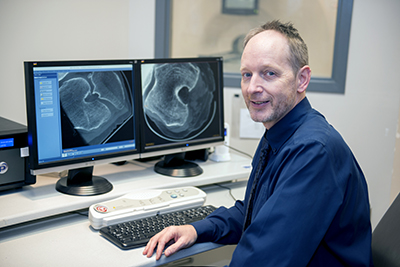From developing state-of-the-art techniques to image bones and joints while in motion to helping more people receive a kidney transplant, researchers in London are working on projects that will impact patient lives. These researchers at Lawson Health Research Institute (Lawson) and Western University’s Schulich School of Medicine & Dentistry have been awarded close to $30 million in funding from the Canadian Institutes for Health Research (CIHR).
More than half of that funding was awarded to five research teams through CIHR’s new foundation grants, designed to provide long-term support for the pursuit of innovative, high-impact research programs.
Living Kidney Donation: Improving safety, access and outcomes ($5.3 million)
Above: Dr. Amit Garg
A team led by Lawson researcher Dr. Amit Garg, MD, FRCPC, PhD, Director of Living Kidney Donation at London Health Sciences Centre (LHSC), Director of the Institute for Clinical Evaluative Sciences' satellite site at Western (ICES Western) and Lead of the Provincial ICES Kidney, Dialysis and Transplantation Program, has been awarded $5.3 million by the CIHR Foundation Scheme. The grant will be used over 7 years to investigate identified barriers to living donor kidney transplantation and create real-world solutions that will improve the experiences and outcomes of donors and their recipients.
“Working with over 13 partnering organizations, this program’s impact has the potential to extend beyond Canada to improve the experiences of 260,000 living donor candidates and recipients who are evaluated worldwide each year,” said Dr. Garg, who is also a professor at Schulich Medicine & Dentistry. “By addressing key barriers to living kidney donation and informing new programs and policies, the outputs of this program are designed to help increase the rate of living kidney transplants in Canada by 25 per cent, which could save our healthcare system $75 million in averted dialysis costs in the subsequent decade.”
This work is being carried out in partnership with 13 partner organizations: Lawson and LHSC, Ottawa Hospital Research Institute, Kidney Foundation of Canada, Kidney Disease | Improving Global Outcomes (KDIGO), Population Health Research Institute, Health Information Research Unit, Canadian National Transplant Research Program, ICES, Canadian Blood Services, The Ontario Renal Network, Western University - Division of Nephrology, Trillium Gift of Life Network and the Donor Nephrectomy Outcomes Research (DONOR) Network.
Dynamic Imaging of the Musculoskeletal System ($3.2 million)
Above: David Holdsworth, PhD
$3.2 million in funding will support work led by David Holdsworth, PhD, and his research team at Robarts Research Institute and Western’s Bone & Joint Institute to allow them to develop new types of biomedical imaging systems to monitor the musculoskeletal system and all of its intricately connected parts, during activity.
The goal is to improve our understanding of the way that skeletal tissues respond to mechanical loading and the conditions that lead to joint failure and degradation. Using state-of-the-art technologies, the team is working to gather entirely new information about the skeletal system with the goal of improving the understanding of the initiation and progression of bone and joint conditions.
“We already have several techniques to look at bones and joints, but typically only when they are stationary. This is a limitation, because many problems with joints only occur when they are in motion,” said Holdsworth, who is also Director for the Dr. Sandy Kirkley Centre for Musculoskeletal Research at Lawson. “We hope that our research will lead to better understanding of the processes behind musculoskeletal disease progression, leading to more effective treatments.”
For a full list of funded projects at Lawson and Schulich Medicine & Dentistry, please see below:
Foundation Grants
- Everling, Stefan (Program Leader) - Muscarinic cholinergic modulation of cognition in primates
- Garg, Amit (Program Leader) - Living Kidney Donation: Improving safety, access, and outcomes
- Holdsworth, David W (Program Leader) - Dynamic Imaging of the Musculoskeletal System: From Cells to Humans
- Menon, Ravi S (Program Leader) - Ultra-high field Magnetic Resonance Imaging of Brain Structure and Function in Multiple Sclerosis
- Pruszynski, Andrew P (Program Leader) - Feature extraction in the tactile periphery: from basic neural mechanisms to better treatments for nerve injury
Project Grants
- Bauer, Greta R ; Lawson, Margaret - Transgender youth in clinical care: A panCanadian cohort study of medical, social and family outcomes
- Bhattacharya, Moshmi - Targeting Triple Negative Breast Cancer: Role of KISS1R
- Borradaile, Nica M - Roles of elongation factor 1A1 in the progression of nonalcoholic fatty liver disease
- Dekaban, Gregory A ; Brown, Arthur - Anti-CD11d immunotherapy for CNS trauma
- Edgell, David - Use of Tev-Cas9 dual nucleases to bias genome editing outcomes towards homology directed repair
- Everling, Stefan - Muscarinic modulation of working memory for abstract rules and cognitive control in nonhuman primates
- Finger, Elizabeth; Boxer, Adam - A phase 2 study of intranasal oxytocin for Frontotemporal Dementia
- Forchuk, Cheryl; Velji, Karima; Richardson, Jan - Smart Homes: Developing and Testing Strategies Supporting Community Re-Integration for Clients with Severe Mental Illness
- Foster, Paula J - Developing In Vivo Imaging Technologies for Quantification of Tumour Associated Macrophages in Breast Cancer
- Frewen, Paul A ; Lanius, Ruth - A Randomized Controlled Trial of Mindfulness Meditation for PTSD with or without Neurofeedback Augmentation
- Gaede, Stewart - Identification of acute radiation-induced cardiac toxicity after locally advanced non-small cell lung cancer radiotherapy with hybrid PET-MRI
- Gill, Sean E - The role of tissue inhibitors of metalloproteinases in microvascular endothelial cell dysfunction during sepsis
- Inoue, Wataru - Chronic stress, synaptic remodelling and neuroendocrine adaptation
- Khan, Ali R ; Kohler, Stefan - Probing hippocampal integrity with ultra-high resolution MRI and behaviour in temporal lobe epilepsy
- Kramer, James M - Functional investigation of the SWI/SNF chromatin remodeling complex in neuronal development and function
- Laird, Dale W ; Allman, Brian - Connexins and pannexins in hearing loss
- Lanius, Ruth A ; McKinnon, Margaret - Neural, cognitive and biological correlates of the dissociative subtype of PTSD among military members
- Li, Shun-Cheng S - Characterization of a new histone mark in stem cell differentiation
- Mann, Jamie F - Evaluating the HIV cellular reservoir in preclinical and Phase 1 clinical trial samples after latency reversal with activator vaccines.
- Mymryk, Joseph S - Molecular genetic analysis of adenovirus E1A function
- O'Gorman, David - The roles of WT1 in fibrosis development
- Parraga, Grace - Change the Outcome: Development and Application of MRI for COPD and Asthma
- Pasternak, Stephen H - Understanding lysosomal secretion in neurons: a novel mechanism responsible for beta-amyloid release
- Ramachandran, Rithwik - Dissecting Proteinase Activated Receptor-4 signaling in the cardiovascular system
- Regnault, Timothy R - Modulating the in utero environment to prevent later life insulin resistance
- Schemitsch, Emil H; Nauth, Aaron; Mckee, Michael D - The DECIPHER Study: DEterminants of Function and Clinically Important outccomes in Proximal Humerus Fractures in the Elder Population: A National CohoRt
- St. Lawrence, Keith S - Imaging cerebral perfusion and energy metabolism at rest and during functional activation by hybrid PET/MRI
- Weir, Matthew - Micro-Particle Curcumin for the Treatment of Chronic Kidney Disease-1 (MPAC-CKD-1)



